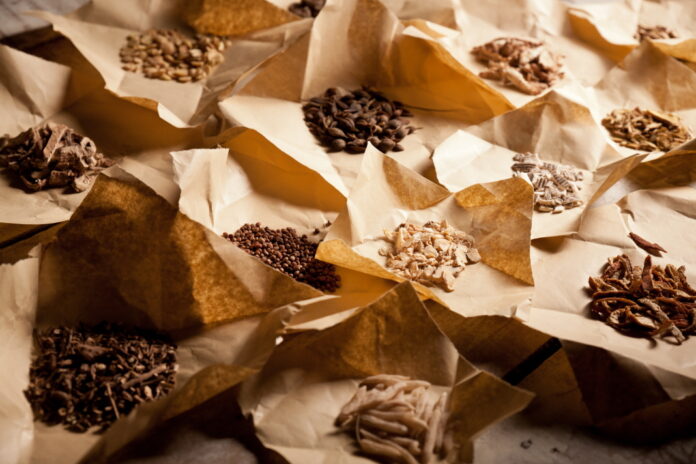Shi Gao Could Be Used for Inflammation, Thirst and Psychotic Symptoms
By Hyunchang Cho, L.Ac., Ph.D
|
★Shi Gao Symptom Indicator Score+ Frequency of Use++ Possible Symptoms ①Localized redness and heat due to acute inflammation ②Thirst ③Psychotic symptoms due to elevated body temperature and excitement of cranial nerves ④Excessive Heat Pattern: energetic, with a reddish face and an aversion to heat (heat intolerance) TIP ⑤Only Possible symptoms exist. Shi Gao’s Indicator Score is low, which means its clinical tips are obscure and hard to find. |
- Pharmacological Hypothesis of Shi Gao
|
Hyperactive body mechanism leading to increased thermogenesis |
Hypocalcemia model: Shi Gao’s main ingredients are calcium compounds(CaSO4/2H2O, 95% or more) →Some hypocalcemia symptoms are treatable with Shi Gao |
|||||
|
↓ |
↓ |
|||||
|
-Excessive Heat Type: strong-built, with a reddish complexion, aversion to heat (heat intolerance), preference for cold food and water, thirst -Acute inflammation: localized redness -Febrile coma: Yang-type psychological symptoms due to increased body temperature and excitement of cranial nerves |
-Hyperthermia: polyuria, polydipsia, polyphagia -Neuromuscular symptoms: whole body seizures (local, minor and major seizures) -Neurological symptoms and signs: mental instability, anxiety, aggressiveness -Mental issues: mental changes, disorientation, stupor, confusion, and such |
|||||
|
↓ |
↓ |
|||||
|
-Excessive Heat Types who are strong-built, with reddish complexion and aversion to heat (heat intolerance) -Thirst -Localized redness and heat due to acute inflammation -Delirium and psychotic tantrums due to increased body temperature and excitement of cranial nerves |
Disagreement: Shi Gao decoctions only contain a small amount of calcium, much less than the RDA (Recommended Daily Allowance) ☞ Therapeutic effects of Shi Gao are from combined effects of main ingredients and other minerals contained in Shi Gao rather than the single effect of calcium compounds alone. Some say the hypocalcemia model does not offer enough explanation for the therapeutic effects of Shi Gao. Although Shi Gao’s main ingredients are calcium compounds, Shi Gao decoctions contain minuscule calcium, much less than the RDA (Recommended Daily Allowance). Therefore, I would like to suggest that the therapeutic effects of Shi Gao, Long Gu, and Mu Li may come from combined effects of main ingredients and other minerals. |
|||||
1) Shi Gao’s main ingredients are calcium compounds (CaSO4/2H2O, 95% or more) and are thought to have therapeutic effects on selective symptoms of hypocalcemia.
-Hyperthermia: polyuria, polydipsia, polyphagia
-Neuromuscular symptoms: whole body seizures (local, minor and major seizures)
-Neurological symptoms and signs: mental instability, anxiety, aggressiveness
-Mental issues: mental changes, disorientation, stupor, confusion, and such
2) Shi Gao’s pattern seems to be caused by hyperactive body and thermal mechanisms. This is how Bai Hu Tang is used for people who are Excessive Heat Types: strong-built, energetic, aversion to heat (heat intolerance), with a reddish face, thirst, and preference for cold/cool food and water.
3) Febrile coma: the excitement of cranial nerves due to increased body temperature seems to cause Yang-type psychological symptoms such as delirium and psychotic tantrums.
4) Shi Gao may treat acute inflammation. When the patient shows signs of acute inflammation such as redness and heat in clinical practice, we can consider Heat Clearing herbs such as Shi Gao, Zhi Zi, Huang Lian, Chai Hu, Huang Qin, Gan Sui, and such.
Some say that the hypocalcemia model does not offer enough explanation for the therapeutic effects of Shi Gao. Although Shi Gao’s main ingredients are calcium compounds, Shi Gao decoctions will only contain miniscule amount of calcium, much less than the RDA (Recommended Daily Allowance). Therefore I suggest that the therapeutic effects of Shi Gao, Long Gu, and Mu Li come from combined effects of main ingredients and other minerals.
Shi Gao’s therapeutic effects can also be explained with hyperactive body and thermal mechanisms for symptoms such as Excessive Heat patterns, febrile coma, and acute inflammation, other than just the hypocalcemia model.
Shi Gao’s pattern seems to be caused by hyperactive body mechanisms and resulting hyperactive thermal mechanisms. This is especially true for Bai Hu Tang, which is comprised of Shi Gao, Zhi Mu, Jing Mi, Gan Cao, with Shi Gao as the main ingredient. Bai Hu Tang patients are Excessive Heat Types who are strong, reddish complexion, aversion to heat (heat intolerance), thirst, and preference for cold/cool food and water.
An increase in body temperature seems to cause excitement of the cranial nerves, just as in a febrile coma. This is why Shi Gao patients can show signs of Yang-type psychological symptoms such as delirium and psychotic tantrums.
Five major symptoms of acute inflammation are pain, redness, immobility, swelling, and heat (PRISH). When the patient shows signs of acute inflammation such as redness and heat, we can consider Heat Clearing herbs such as Shi Gao, Zhi Zi, Huang Lian, Chai Hu, Huang Qin, Gan Sui, etc. Shi Gao seems to have therapeutic effects of treating acute inflammation.
Shi Gao’s therapeutic effects are on the opposite end of Fu Zi’s, summarized as a hypoactive body and thermal mechanism. But this model is insufficient to explain the therapeutic effects of Shi Gao formulas such as Zhu Ye Shi Gao Tang and Mu Fang Yi Tang, in which patients are not that strong-built and don’t show strong aversions to heat.

































